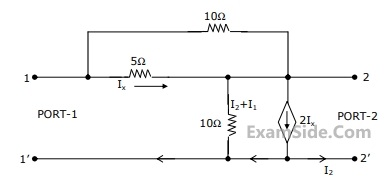1
GATE ECE 2002
Subjective
+5
-0
Consider the network in Fig.

(a) Find its short-circuit admittance parameters.
(b) Find the open-ciruit impedance $${Z_{22}}$$.

2
GATE ECE 2001
Subjective
+5
-0
The admittance parameters of a 2-port network shown in Fig. are given by $${Y_{11}} = \,2\,\,mho$$, $${Y_{12}}$$ = - 0.5 mho, $${Y_{21}}$$ = 4.8 mho, $${Y_{22}}$$ = 1 mho. The output port is terminated with a load admittance $${Y_L}$$ = 0.2 mho. Find $${E_2}$$ for each of the following conditions:

(a) $${E_1} = \,10\,\angle \,{0^{ \circ \,}}\,V$$
(b) $${I_1} = \,10\,\angle \,{0^{ \circ \,}}\,A$$
(c) A source $$10\,\angle \,{0^{ \circ \,}}\,V$$ in series with a 0.25 $$\Omega $$ resistor is connected to the input port.

3
GATE ECE 1996
Subjective
+5
-0
Find the input resistance $${R_{in}}$$ of the infinite section resistive network shown in Fig.


4
GATE ECE 1996
Subjective
+5
-0
The open circuit impedance matrix $${Z_{OC}}$$ of a three-terminal two-port network with A as the input terminal, B as the output terminal, and C as the common terminal, is given as
$$$\left[ {{Z_{OC}}} \right] = \left[ {\matrix{
2 & 5 \cr
3 & 7 \cr
} } \right]$$$
Write down the short circuit admittance matrix $${{Y_{SC}}}$$ of the network viewed as a two-port network, but now taking B as the input terminal, C as the output terminal and A as the common terminal.
Questions Asked from Two Port Networks (Marks 5)
Number in Brackets after Paper Indicates No. of Questions
GATE ECE Subjects
Signals and Systems
Representation of Continuous Time Signal Fourier Series Discrete Time Signal Fourier Series Fourier Transform Discrete Time Signal Z Transform Continuous Time Linear Invariant System Transmission of Signal Through Continuous Time LTI Systems Discrete Time Linear Time Invariant Systems Sampling Continuous Time Signal Laplace Transform Discrete Fourier Transform and Fast Fourier Transform Transmission of Signal Through Discrete Time Lti Systems Miscellaneous Fourier Transform
Network Theory
Control Systems
Digital Circuits
General Aptitude
Electronic Devices and VLSI
Analog Circuits
Engineering Mathematics
Microprocessors
Communications
Electromagnetics